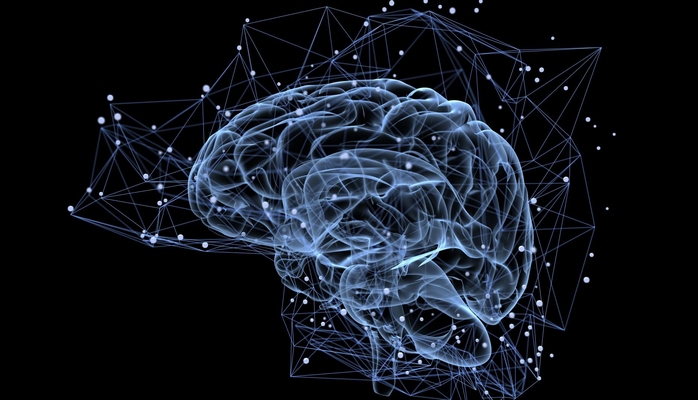
Is ‘mindfulness’ all in your head?
How many times have you heard someone say to a person who is angry and agitated, “Hey, take a few deep breaths and chill.” Well, it works, and there’s now a physiological explanation for it. And for the popularity of the “mindfulness” phenomenon, which has spread rapidly worldwide. (A Google search for the word yields more than 138 million hits!)
Located deep in the brainstem, there is a tiny cluster of neurons that links respiration to feelings of relaxation, attention, excitement and anxiety. Called the “pacemaker for breathing,” it communicates the activity in the brain’s respiratory control center to the structure responsible for generating arousal throughout the brain. It is this region of the brain that mediates how slow, smooth, rhythmic breathing induces a state of calm.
Researchers studying this cluster have found that mice whose neurons have had two specific genes “knocked out,” or eliminated, are more “mellow,” and that they have altered breathing patterns – that is, different proportions of different kinds of breaths. Specifically, “there were fewer fast ‘active’ and faster ‘sniffing’ breaths, and more slow breaths associated with chilling out.”
The researchers believe that this is how a person can control breathing in order to shift consciousness from an aroused or even agitated state to a more meditative one, a basic aspect of virtually all varieties of yoga and related disciplines, including mindfulness.
The relationship of breathing control to the state of arousal versus tranquility is a critical component of mindfulness, which has been described as “awareness that arises through paying attention, on purpose, in the present moment, non-judgmentally” and “about knowing what is on your mind.” According to the mindful.org website, the meditation aspect of it focuses on breathing “because the physical sensation of breathing is always there and you can use it as an anchor to the present moment.”
Mindfulness seems these days to pop up everywhere. Companies like Apple, Sony, Ikea, and Google have added mindfulness or meditation to their employee benefit packages in hopes of cultivating a happier, more productive workforce. Hospitals offer mindfulness meditation sessions to patients and employees. Schools have implemented mindfulness “time-outs” for rowdy elementary-school kids, and one of the take-home lessons for weight control from the 2016 European Congress on Obesity was “Be Mindful.” In addition, last year the New York Times’ “Well” section ran more than a dozen articles about mindfulness, including “How to Be Mindful While Cleaning the Bathroom” and “How to Be Mindful While Having a Root Canal Without Anesthesia. (OK, we made up that last one.)
The claims for mindfulness are extravagant, with its advocates claiming it can improve a number of conditions including anxiety, depression, stress, and even drug addiction. A large number of studies over the last 30 years (see meta-analyses here and here) purportedly have shown that when mindfulness is practiced regularly, people experience positive changes in their sense of well-being, their relationships, their ability to concentrate, their experience of physical and emotional pain, and their capacity to enjoy life.
However, many (most?) of these studies seem to be observational (that is, uncontrolled) or poorly controlled, and they are susceptible to “publication bias,” or the “file drawer effect,” the tendency to publish only studies that support the hypothesis. We wonder how, in a randomized controlled study, mindfulness would compare to other stress-reducing interventions--for example, getting a puppy; a regular regime of hiking; or yoga, with which it has many similarities.
Could mindfulness become too much of a good thing? In some cases it has morphed into something that resembles a cult, and some practitioners have reported feelings of depersonalization and detachment and even loss of identity. Others have had more extreme reactions including psychosis, delusions, confusion, mania or depression. Maybe such outcomes are not surprising, given that mindfulness encourages exploration of experiences with a nonjudgmental attitude, and those experiences may be neutral or negative, as well as positive.
We also wonder whether the adoption of mindfulness by so many high-tech companies is an attempt to, in effect, paper over the real problem of chronically overworked, stressed employees. At a time when many companies are adopting cost-cutting measures such as reducing overtime pay and laying off workers, employees are being pushed to boost their productivity. Rather than addressing the real issues of higher pay or hiring more workers, might they simply be helping workers cope with job stress by implementing meditation programs?
Some in Silicon Valley frankly view mindfulness as a way to improve productivity, rather than a transcendent form of reflection. The goal is to improve one’s emotional intelligence (EI), which is supposed to help people to understand coworkers’ motivations and provide a competitive edge. Chade-Meng Tan, the founder of the Search Inside Yourself Leader Institute (providers of mindfulness and meditation courses to Google) and former Google employee #107, told Wired magazine, “Everybody knows this EI thing is good for their career, and every company knows that if their people have EI, they’re gonna make a shitload of money.”
Not all the Silicon Valley fast-trackers agree. In fact, some have taken a diametrically opposite approach: fasting or using brain-enhancing drugs called nootropics, which include stimulants, hallucinogenics and even vitamins administered via an intravenous drip. (Sometimes, all at once.) They’re trying to “hack their brain chemistry,” similar to the way that computer hacking is done. We hope they understand that a fundamental difference between human brains and computers is that if you screw up a computer beyond repair, you can just send it to eWaste and get a new one.
We are not surprised that many people are searching for a way to escape their quotidian cares. The past year brought us terror school shootings, Hurricane Michael, California wildfires, the worst flu season in decades, and ongoing battles in the Culture Wars. If deep breathing and focusing on the here and now can help erase those memories, sign us up.
Mia Zaharna is a psychiatrist specializing in sleep disorders.
Source: Foxnews.com



Comments
Show comments Hide comments